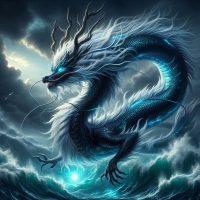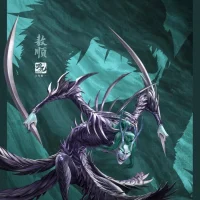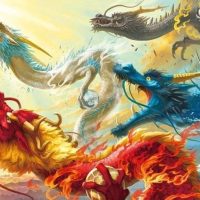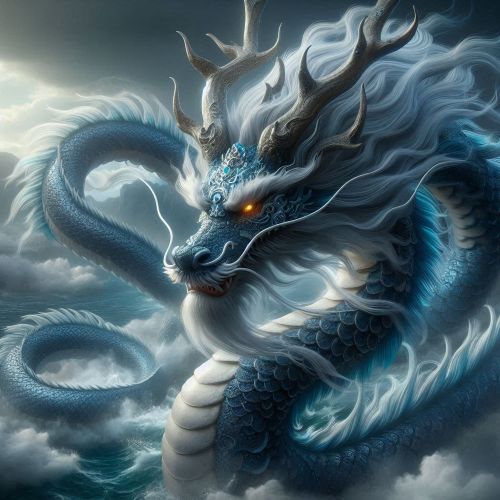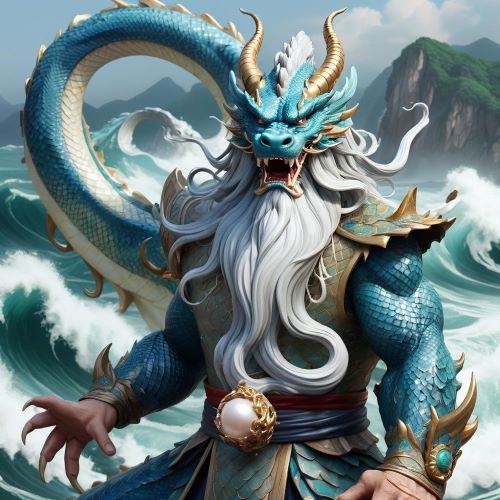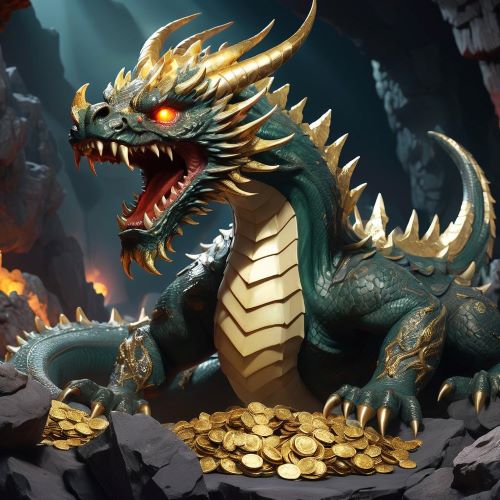Ao Shun : Dragon of Northern Seas
Listen
At a glance
| Description | |
|---|---|
| Origin | Chinese Mythology |
| Classification | Animals |
| Family Members | Ao Run, Ao Qin, Ao Guang |
| Region | China |
| Associated With | Northern Seas |
Ao Shun
Introduction
Ao Shun (敖顺) stands as one of the four mighty Dragon Kings in Chinese mythology, revered as the Dragon King of the North Sea (北海龙王). In the vast pantheon of Chinese deities, the Dragon Kings hold dominion over the cardinal seas—each representing a direction, an element, and a natural balance. Ao Shun’s reign over the frigid northern waters makes him the embodiment of mystery, power, and the untamed spirit of nature. His presence in ancient texts and temple traditions reflects the profound respect ancient China held for dragons as bringers of rain, guardians of rivers, and intermediaries between heaven and earth. As the ruler of the North, Ao Shun symbolizes endurance, the depths of wisdom, and the strength found within stillness and ice.
Physical Traits
Ao Shun is often envisioned as a majestic Chinese dragon with an elongated, serpentine form, covered in scales that shimmer with deep blue, silver, or black hues reminiscent of icy ocean depths. His antler-like horns curve gracefully, his whiskers flow like ribbons in the current, and his eyes glow with divine intelligence. Artists frequently depict him surrounded by mist and waves, or coiled around a luminous pearl—a sacred emblem of wisdom and dominion over water. Unlike Western dragons, who are often feared for destruction, Ao Shun’s visage conveys authority tempered with benevolence. In human guise, he is sometimes portrayed as an elder monarch draped in ocean-colored robes, a crown resembling coral and ice adorning his brow. Every detail of his depiction reinforces his identity as a ruler of both natural and spiritual realms.
Family
Ao Shun belongs to the divine lineage of dragon deities that govern the waters of the world. He is one of the four brothers—each a Dragon King presiding over one of the Four Seas encircling ancient China. His siblings include Ao Guang of the East Sea, Ao Qin of the South Sea, and Ao Run of the West Sea. Together, they form a celestial brotherhood tasked with maintaining the balance of rainfall, tides, and aquatic life across the empire. Their father, often referred to as the Dragon God or the Dragon Ancestor, represents the primordial origin of all dragons, embodying the cosmic principle of water’s movement and transformation. Within this lineage, Ao Shun is often portrayed as the most contemplative and reserved, reflecting the austere nature of his northern domain. In some folktales, he is also said to have a host of children—minor dragon princes and princesses who act as guardians of rivers, lakes, and mountain springs.
Other names
Though “Ao Shun” remains the most common name across literature and worship, he is also known by other epithets that highlight his authority and elemental alignment. Among these, Beihai Longwang (北海龙王), meaning “Dragon King of the North Sea,” is the most revered temple title. In poetic texts, he is occasionally called Xuanlong (玄龙), “The Dark or Mysterious Dragon,” symbolizing the deep, cold, and enigmatic nature of the northern waters. The prefix “Ao” (敖) itself is shared among all four Dragon Kings, marking their celestial kinship. These variations across regions and texts not only reflect linguistic diversity but also emphasize how deeply Ao Shun’s myth is rooted in both religion and geography.
Powers and Abilities
As a divine being, Ao Shun’s powers extend far beyond the mortal imagination. His mastery over the element of water grants him absolute control over tides, currents, rainfall, and marine creatures. He can summon storms and blizzards or calm the sea with a thought. Farmers once prayed to him during droughts, offering sacrifices to invoke rain and fertility. Sailors and fishermen sought his protection before venturing into the open waters, believing that his favor could calm dangerous waves.
Ao Shun is also said to possess the power of transformation, allowing him to assume various forms—dragon, human, mist, or even pure energy. Like his brothers, he commands the Dragon Palace, a magnificent underwater court adorned with coral towers, pearl lanterns, and crystal halls where he rules over aquatic spirits and mythical beasts. His connection to the spiritual pearls, glowing orbs said to contain divine energy, underscores his wisdom and his role as a keeper of balance between heaven and the sea.
In Daoist cosmology, Ao Shun’s role extends to celestial administration: he responds to heavenly decrees concerning weather and water, acting as both enforcer and protector of natural harmony. His wrath, however, is legendary—those who pollute or disrespect the sea risk invoking his tempests.
Modern Day Influence
Though ancient in origin, Ao Shun’s legacy continues to ripple through Chinese culture and modern imagination. Temples dedicated to the Dragon Kings still stand along China’s northern coasts and inland waterways, where devotees offer incense and prayers for rainfall, protection, and prosperity. Festivals celebrating dragon mythology—such as the Dragon Boat Festival—echo the reverence once held for deities like Ao Shun, even if indirectly. In these cultural expressions, he symbolizes the eternal connection between humanity and nature.
In popular media, Ao Shun frequently appears in adaptations of Journey to the West, one of China’s greatest classical novels. There, he is portrayed as a proud yet noble sea ruler who interacts with deities, immortals, and the monk Xuanzang’s companions. His image also surfaces in modern literature, animated series, and video games exploring Chinese myth, where he embodies wisdom, elemental power, and divine justice.
Beyond storytelling, Ao Shun’s myth has found new resonance in environmental thought. In coastal villages, some rituals invoking the Dragon Kings have evolved into eco-spiritual traditions, emphasizing respect for oceans and sustainable water use. Artists and poets use Ao Shun as a symbol of the earth’s enduring forces—beautiful, unpredictable, and worthy of reverence. In contemporary Feng Shui, the dragon motif, rooted in myths of Ao Shun and his kin, remains a potent emblem of strength, prosperity, and harmonious energy.
Today, Ao Shun endures not merely as a deity of the sea but as a living archetype of balance and endurance—a reminder that even the coldest depths conceal life, wisdom, and divine order.
Related Images
Source
Allen, R. (2018). AO SHUN – Chinese Mythology. Godchecker. https://www.godchecker.com/chinese-mythology/AO-SHUN/
Wikipedia contributors. (2025). Chinese mythology. Wikipedia. https://en.wikipedia.org/wiki/Chinese_mythology
Dragon University. (2023, August 8). The nine sons of the dragon: Exploring Chinese mythology. Dragon University. https://dragon.university/the-nine-sons-of-the-dragon-exploring-chinese-mythology/
Sixth Tone. (2024, February 8). How the dragon king emerged from the waves. Sixth Tone. https://www.sixthtone.com/news/1014617/how-the-dragon-king-emerged-from-the-waves
VoVatia. (2015, July 10). Tag Archives: ao shun. https://vovatia.wordpress.com/tag/ao-shun/
Wikipedia contributors. (2025). Dragon King. Wikipedia. https://en.wikipedia.org/wiki/Dragon_King
Schipper, M., Ye, S., & Yin, H. (2025). China’s creation and origin myths: Cross-cultural explorations in oral and written traditions. [PDF]. https://www.scribd.com/document/707604386/Mineke-Schipper-editor-Shuxian-Ye-editor-Hubin-Yin-editor-China-s-Creation-and-Origin-Myths-Cross-cultural-Explorations-in-Oral-and-Written
Kuiken, C. J. (2011). The other Neng [PDF]. University of Groningen. https://research.rug.nl/files/33172267/KuikenCJ-TheOtherNeng-herzien2011.pdf
Yang, L. (2005). Handbook of Chinese Mythology. Oxford University Press.
Birrell, A. (1999). Chinese Mythology: An Introduction. Johns Hopkins University Press.
Wu, K. C. (1982). The Chinese Heritage. Crown Publishers.
Schafer, E. H. (1963). The Divine Woman: Dragon Kings and Rainmaking in Chinese Religion. University of California Press.
Teiser, S. F. (1994). The Ghost Festival in Medieval China. Princeton University Press
Frequently Asked Questions
What is lorem Ipsum?
I am text block. Click edit button to change this text. Lorem ipsum dolor sit amet, consectetur adipiscing elit. Ut elit tellus, luctus nec ullamcorper mattis, pulvinar dapibus leo.
What is lorem Ipsum?
I am text block. Click edit button to change this text. Lorem ipsum dolor sit amet, consectetur adipiscing elit. Ut elit tellus, luctus nec ullamcorper mattis, pulvinar dapibus leo.
What is lorem Ipsum?
I am text block. Click edit button to change this text. Lorem ipsum dolor sit amet, consectetur adipiscing elit. Ut elit tellus, luctus nec ullamcorper mattis, pulvinar dapibus leo.
What is lorem Ipsum?
I am text block. Click edit button to change this text. Lorem ipsum dolor sit amet, consectetur adipiscing elit. Ut elit tellus, luctus nec ullamcorper mattis, pulvinar dapibus leo.
What is lorem Ipsum?
I am text block. Click edit button to change this text. Lorem ipsum dolor sit amet, consectetur adipiscing elit. Ut elit tellus, luctus nec ullamcorper mattis, pulvinar dapibus leo.


